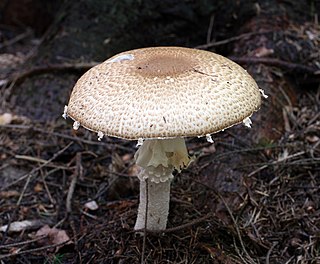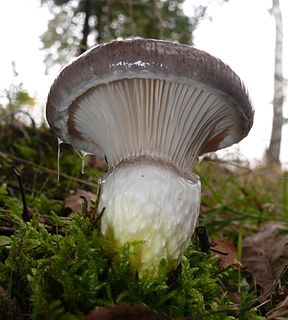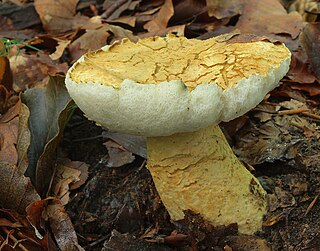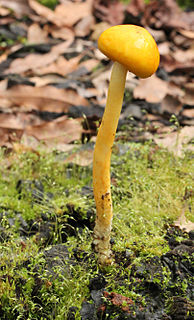
A mushroom or toadstool is the fleshy, spore-bearing fruiting body of a fungus, typically produced above ground, on soil, or on its food source.

Suillus is a genus of basidiomycete fungi in the family Suillaceae and order Boletales. Species in the genus are associated with trees in the pine family (Pinaceae), and are mostly distributed in temperate locations in the Northern Hemisphere, although some species have been introduced to the Southern Hemisphere.

Agaricus augustus, known commonly as the prince, is a basidiomycete fungus of the genus Agaricus.

Gomphidius glutinosus, commonly known as the slimy spike-cap, is a gilled mushroom found in Europe & North America. Although it has gills, it is a member of the order Boletales, along with the boletes. The fruiting bodies sprout in pine, fir and spruce woodland in Europe in autumn. Initially, are completely covered with a slimy veil, breaking through to reveal a greyish or brownish-capped mushroom with decurrent greyish gills which sometimes resembles a child's top. Opinions differ on the suitability of this mushroom for the table, some guides hold it in high regard, while others view it with caution.

Phylloporus rhodoxanthus, commonly known as the gilled bolete, is a species of fungus in the family Boletaceae. As suggested by its common name, the distinctive feature of this species is its yellow gills—an unusual feature on a bolete mushroom.

Suillus lakei, commonly known as the matte Jack, Lake's bolete, or the western painted Suillus, is a species of fungus in the family Suillaceae. It is characterized by the distinctive reddish-brown tufted fibers or small scales on the cap, and the presence of a woolly veil on the stem. The caps can reach diameters of up to 15 cm (5.9 in), while the stems are between 6 to 12 cm long and usually 1–3 cm (0.4–1.2 in) thick. On the underside of the cap is a layer of spongy yellow to yellow-brown angular pores; these pores are covered with a whitish partial veil when young. A mycorrhizal fungus, S. lakei grows in association with Douglas fir, and is found where this tree occurs. It is native to northwestern North America, but has been introduced to Europe, South America, and New Zealand. The mushroom is edible, but opinions vary considerably as to its quality.

Suillus spraguei is a species of fungi in the family Suillaceae. It is known by a variety of common names, including the painted slipperycap, the painted suillus or the red and yellow suillus. Suillus spraguei has had a complex taxonomical history, and is also frequently referred to as Suillus pictus in the literature. The readily identifiable fruit bodies have caps that are dark red when fresh, dry to the touch, and covered with mats of hairs and scales that are separated by yellow cracks. On the underside of the cap are small, yellow, angular pores that become brownish as the mushroom ages. The stalk bears a grayish cottony ring, and is typically covered with soft hairs or scales.

Agaricus deserticola, commonly known as the gasteroid agaricus, is a species of fungus in the family Agaricaceae. Found only in southwestern and western North America, A. deserticola is adapted for growth in dry or semi-arid habitats. The fruit bodies are secotioid, meaning the spores are not forcibly discharged, and the cap does not fully expand. Unlike other Agaricus species, A. deserticola does not develop true gills, but rather a convoluted and networked system of spore-producing tissue called a gleba. When the partial veil breaks or pulls away from the stem or the cap splits radially, the blackish-brown gleba is exposed, which allows the spores to be dispersed.

Suillus pungens, commonly known as the pungent slippery jack or the pungent suillus, is a species of fungus in the genus Suillus. The fruit bodies of the fungus have slimy convex caps up to 14 cm (5.5 in) wide. The mushroom is characterized by the very distinct color changes that occur in the cap throughout development. Typically, the young cap is whitish, later becoming grayish-olive to reddish-brown or a mottled combination of these colors. The mushroom has a dotted stem (stipe) up to 7 cm (2.8 in) long, and 2 cm (0.8 in) thick. On the underside on the cap is the spore-bearing tissue consisting of minute vertically arranged tubes that appear as a surface of angular, yellowish pores. The presence of milky droplets on the pore surface of young individuals, especially in humid environments, is a characteristic feature of this species. S. pungens can usually be distinguished from other similar Suillus species by differences in distribution, odor and taste. The mushroom is considered edible, but not highly regarded.

Cortinarius traganus, also known as the gassy webcap, is a basidiomycete mushroom of the genus Cortinarius. The mushrooms are characterized by their lilac color, the rusty-brown gills and spores, and rusty-brown flesh in the stem.

Cortinarius delibutus, also known as the bluegill webcap or the yellow webcap, is a basidiomycete fungus of the genus Cortinarius. The fruit bodies are medium-sized, with shiny yellow caps on a sticky, yellow-banded club-shaped stem. The mushroom is found in Europe and North America, usually near birch or beech trees.

Cortinarius cinnamomeus, also known as the cinnamon webcap, is a basidiomycete mushroom of the genus Cortinarius. The fungus produces brown fruit bodies with caps up to 6 cm (2.4 in) wide and stems up to 12 cm (4.7 in) long. The closely crowded gills underside the cap are initially yellow before turning brown. Cortinarius cinnamomeus is common in damp places in coniferous forests. It is distributed throughout the temperate zone of the Northern Hemisphere.

Gyroporus cyanescens, commonly known as the bluing bolete or the cornflower bolete, is a species of bolete fungus in the family Gyroporaceae. First described from France in 1788, the species is found in Asia, Australia, Europe, and eastern North America, where it grows on the ground in coniferous and mixed forests.

Amanita ravenelii, commonly known as the pinecone lepidella, is a species of fungus in the family Amanitaceae. The fruit bodies are medium to large, with caps up to 17 cm (6.7 in) wide, and a stem up to 25 cm (9.8 in) long and 3 cm (1.2 in) thick. The warts on the whitish cap surface are large—up to 6 mm (0.24 in) wide and 4 mm (0.16 in) high. The stem has a large bulb at its base, covered with whitish to brownish scales, that may root several centimeters into the soil. The ring on the stem is thick and cotton- or felt-like. It is widely distributed in mixed and deciduous forests of the southeastern United States, where it grows solitarily or in groups on the ground in late summer and autumn. The mushrooms have a unique odor resembling bleaching powder.

Collybia tuberosa, commonly known as the lentil shanklet or the appleseed coincap, is an inedible species of fungus in the family Tricholomataceae, and the type species of the genus Collybia. Like the two other members of its genus, it lives on the decomposing remains of other fleshy mushrooms. The fungus produces small whitish fruit bodies with caps up to 1 cm (0.4 in) wide held by thin stems up to 5 cm (2.0 in) long. On the underside of the cap are closely spaced white gills that are broadly attached to the stem. At the base of the stem, embedded in the substrate is a small reddish-brown sclerotium that somewhat resembles an apple seed. The appearance of the sclerotium distinguishes it from the other two species of Collybia, which are otherwise very similar in overall appearance. C. tuberosa is found in Europe, North America, and Japan, growing in dense clusters on species of Lactarius and Russula, boletes, hydnums, and polypores.

Suillus cothurnatus is a species of mushroom in the genus Suillus. Found in Malaysia, Brazil, and North America, it was first described scientifically by mycologist Rolf Singer in 1945.

Suillus salmonicolor, commonly known as the Slippery Jill, is a fungus in the family Suillaceae of the order Boletales. First described as a member of the genus Boletus in 1874, the species acquired several synonyms, including Suillus pinorigidus and Suillus subluteus, before it was assigned its current binomial name in 1983. It has not been determined with certainty whether S. salmonicolor is distinct from the species S. cothurnatus, described by Rolf Singer in 1945. S. salmonicolor is a mycorrhizal fungus—meaning it forms a symbiotic association with the roots of plants such that both organisms benefit from the exchange of nutrients. This symbiosis occurs with various species of pine, and the fruit bodies of the fungus appear scattered or in groups on the ground near the trees. The fungus is found in North America, Hawaii, Asia, the Caribbean, South Africa, Australia and Central America. It has been introduced to several of those locations via transplanted trees.

Butyriboletus regius, commonly known as the royal bolete or red-capped butter bolete, is a basidiomycete fungus of the genus Boletus found in China and Europe. B. regius has a pink cap, yellow flesh, and a reticulate pattern on the stem. Harry D. Thiers described a similar mushroom from California as B. regius, though it is not the same species. B. regius in Europe does not stain when exposed to air, or stains weakly, but the California species stains blue. Both European and California species are considered choice edibles.

Boletus curtisii is a species of fungus in the family Boletaceae. It produces small- to medium-sized fruit bodies (mushrooms) with a convex cap up to 9.5 cm (3.7 in) wide atop a slender stem that can reach a length of 12 cm (4.7 in). In young specimens, the cap and stem are bright golden yellow, although the color dulls to brownish when old. Both the stem and cap are slimy or sticky when young. On the underside of the cap are small circular to angular pores. The mushroom is edible, but not appealing. It is found in eastern and southern North America, where it grows in a mycorrhizal association with hardwood and conifer trees. Once classified as a species of Pulveroboletus, the yellow color of B. curtisii is a result of pigments chemically distinct from those responsible for the yellow coloring of Pulveroboletus.

Pulveroboletus ravenelii, commonly known as Ravenel's bolete or the powdery sulfur bolete, is a species of bolete fungus in the family Boletaceae. Described as new to science in 1853, the widely distributed species is known from Asia, Australia, North America, Central America, and South America. Mycorrhizal with oak, the fungus fruits on the ground singly, scattered, or in groups in woods. Fruit bodies (mushrooms) have convex to flat, yellowish to brownish-red caps up to 10 cm (4 in) in diameter. On the cap underside, the pore surface is bright yellow before turning dingy yellow to grayish brown with age; it stains greenish blue then grayish brown after injury. A cottony and powdery partial veil remains as a ring on the stipe. The mushrooms are edible, and have been used in traditional Chinese medicine and for mushroom dyeing.

























